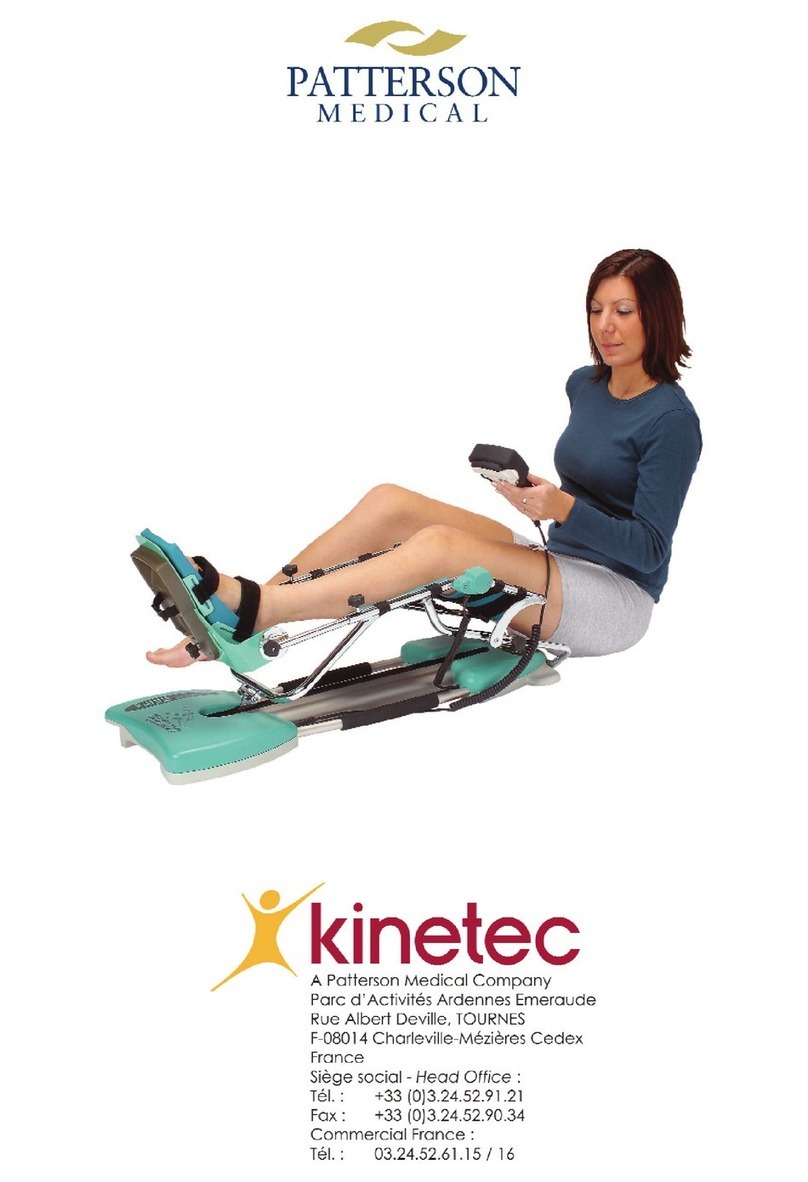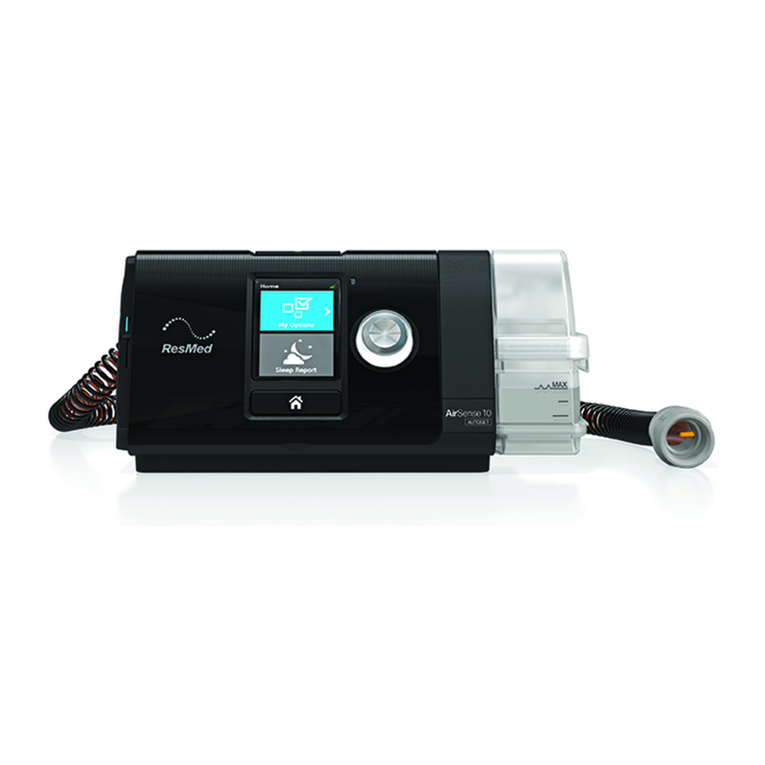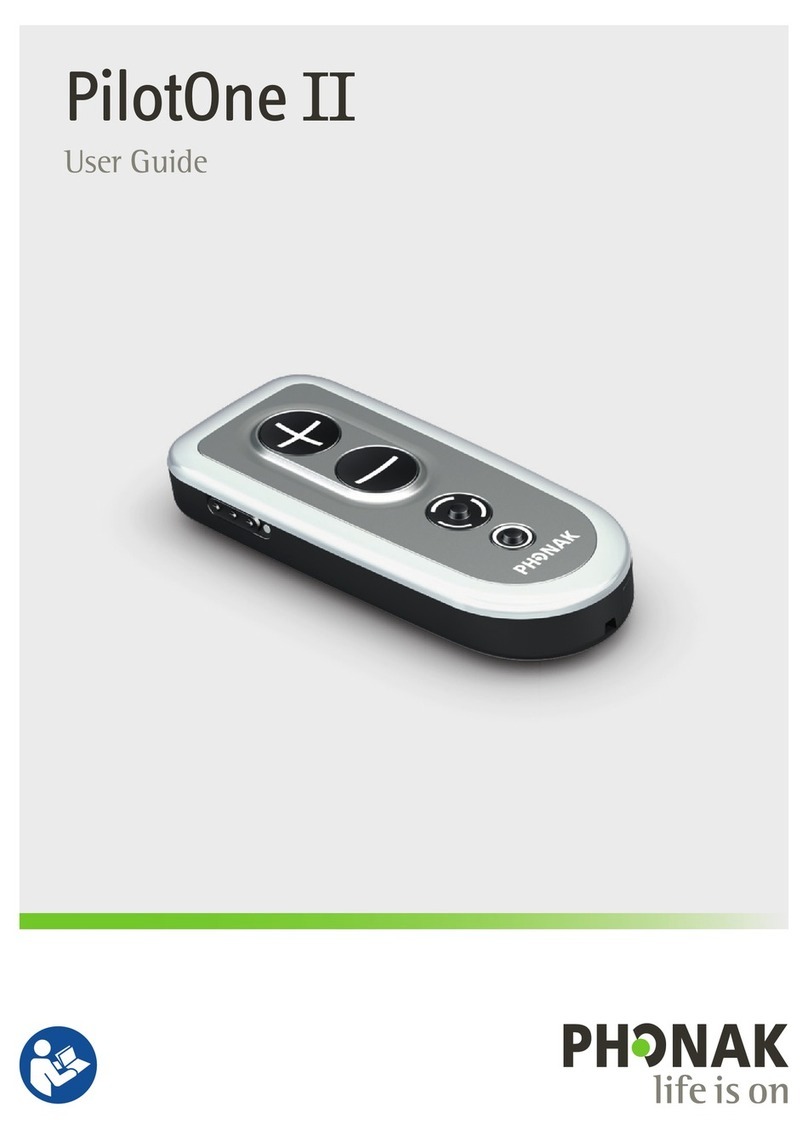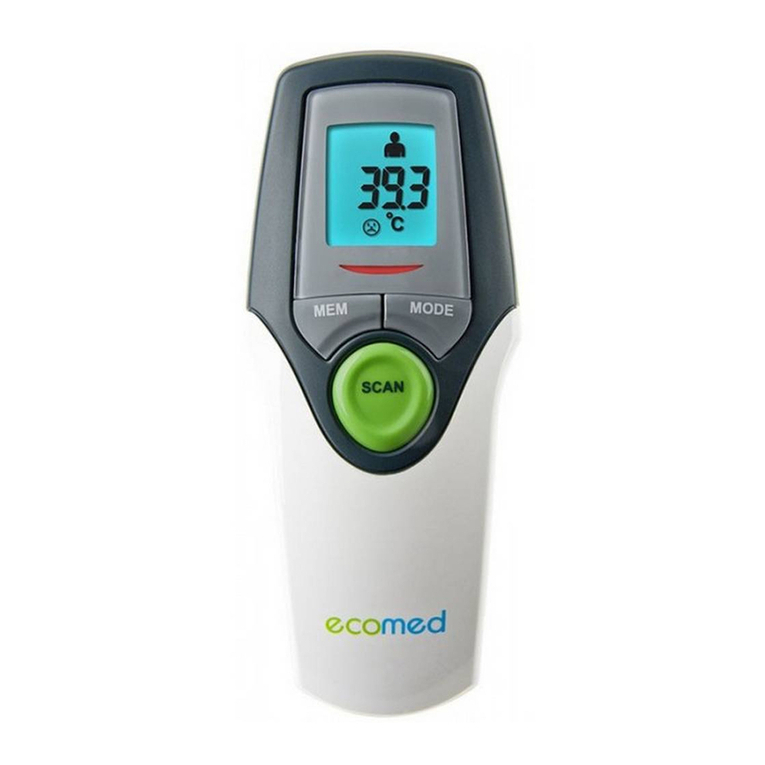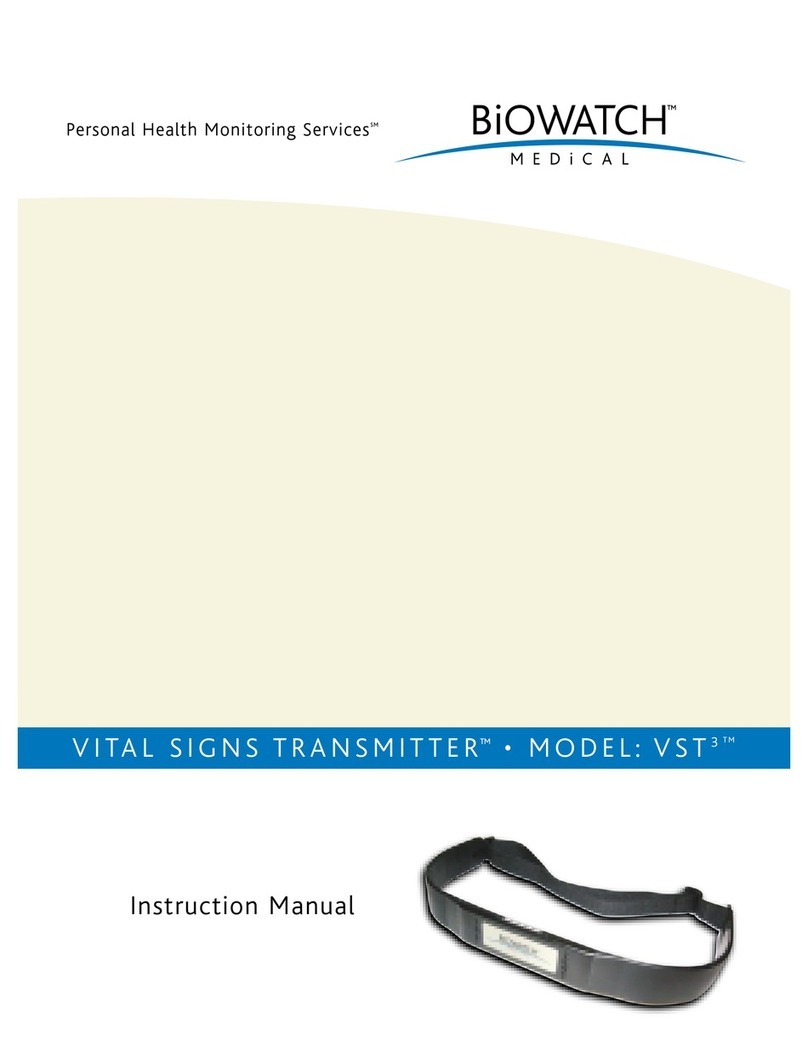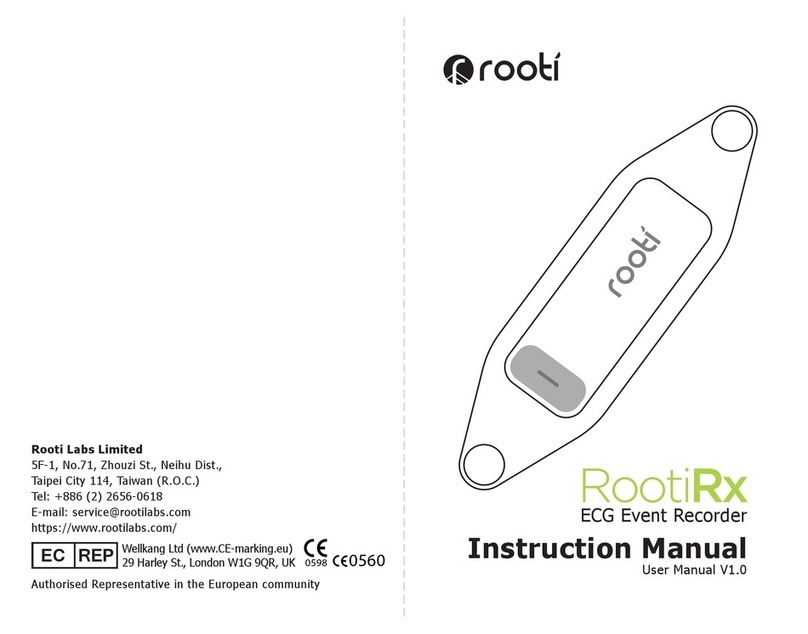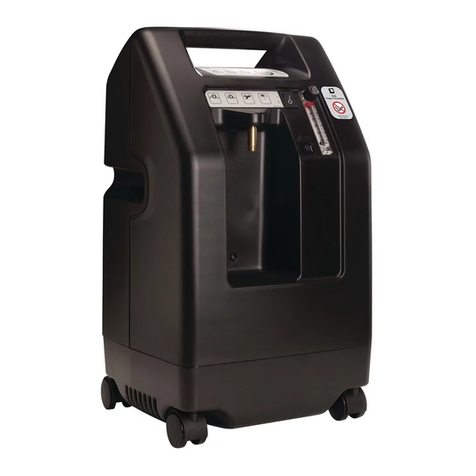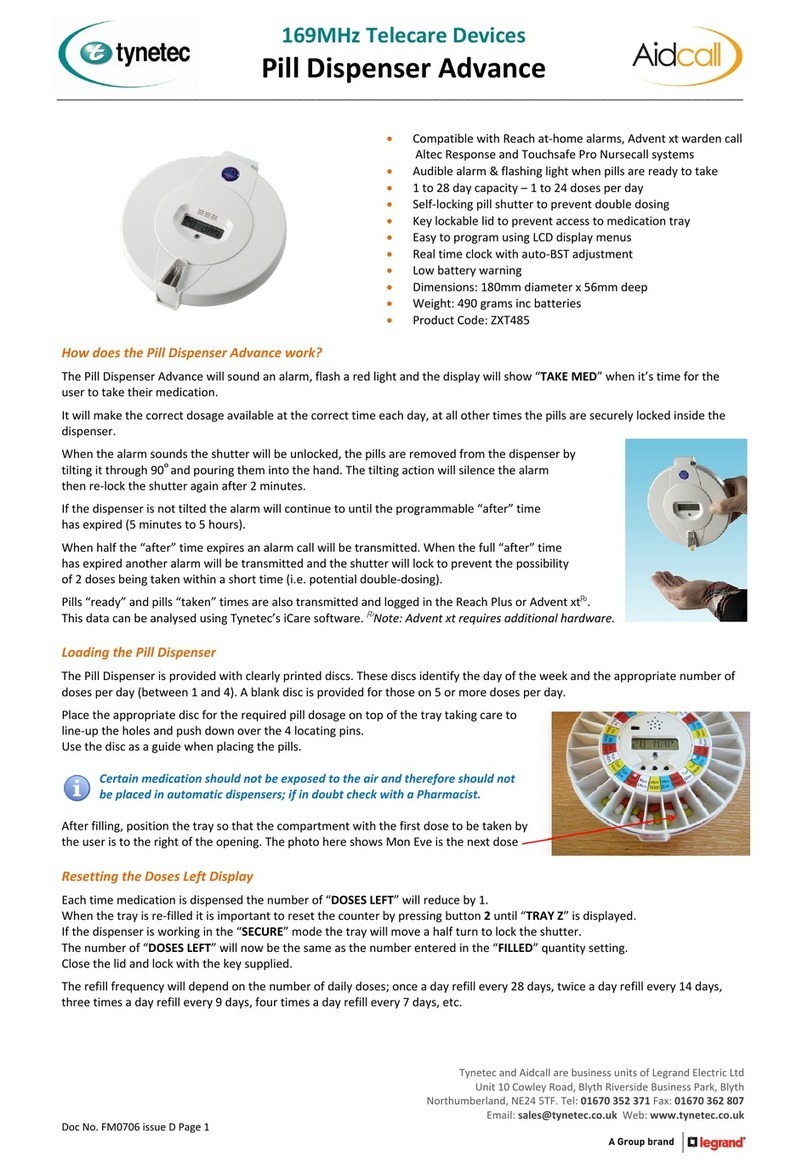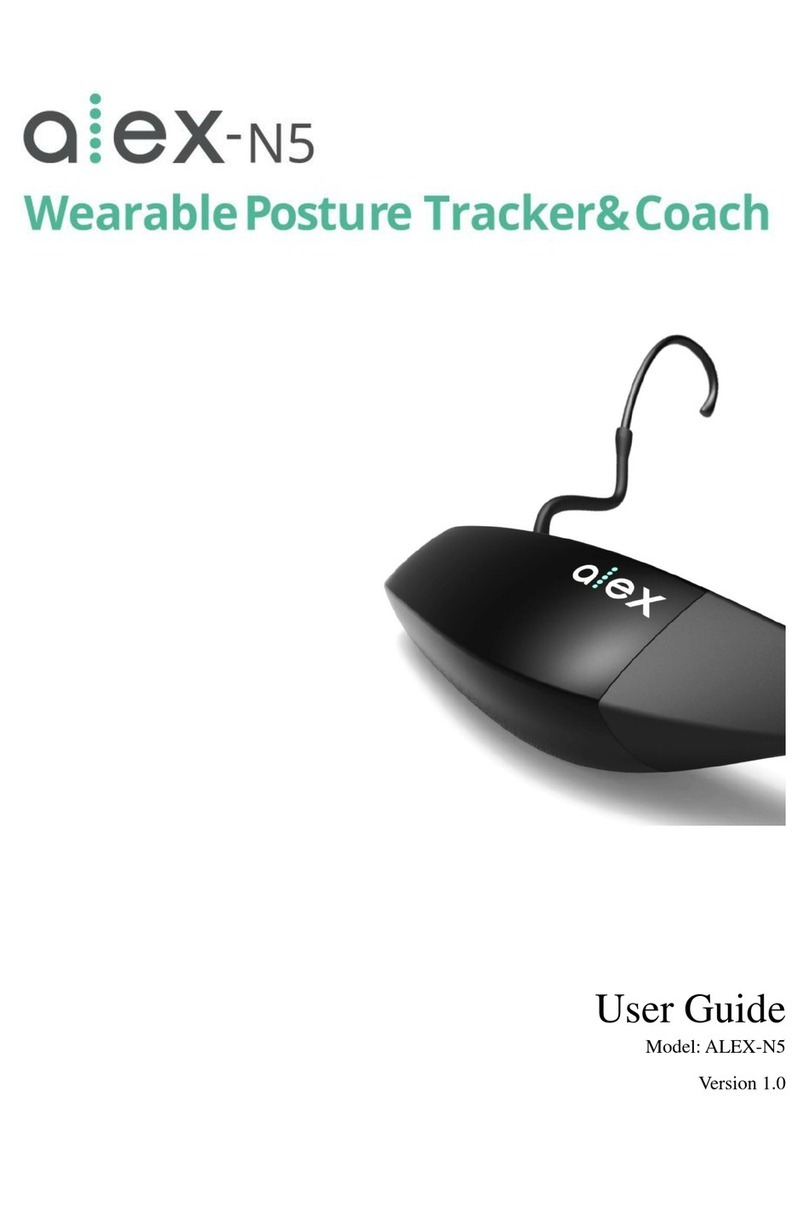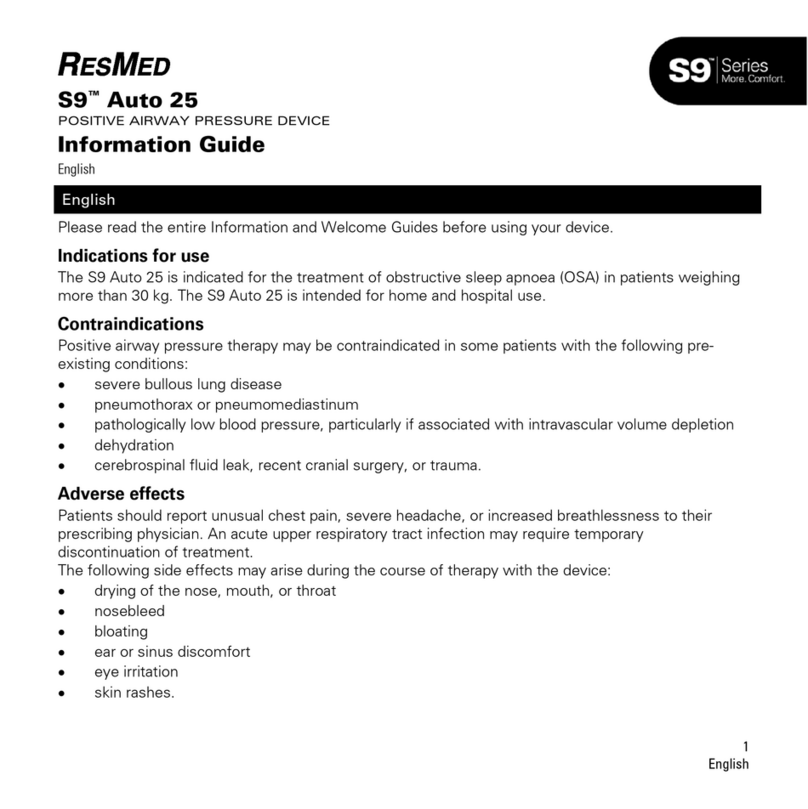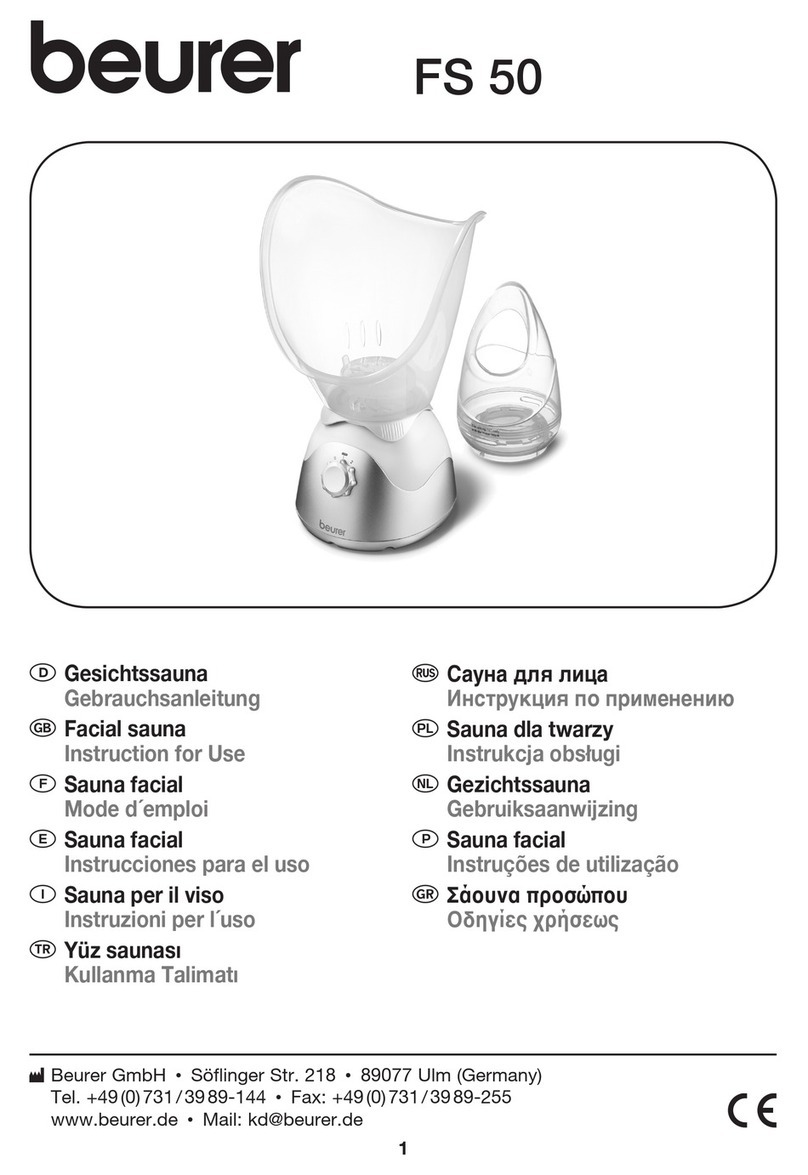HeartSine samaritan PAD SAM 500P User manual

User Manual
HeartSine samaritan®PAD
SAM 500P

2
Contents
Contents 2
Indications for Use 4
Indications for use 4
Contraindications for use 4
Intended users 4
Warnings and Cautions 5
Introduction 10
The SAM 500P 10
Sudden cardiac arrest (SCA) 10
Ventricular brillation 10
CPR quality 11
Impedance cardiogram 11
Recommended training 12
CPR metronome 12
SAM 500P Overview 13
Preparation 14
Unpacking 14
Checks before putting into service 14
Preparation checklist 16
Using the SAM 500P 17
When to use 17
Using the SAM 500P 17
After use 18
Pediatric-Pak 20
Service and Maintenance 22
Tracking Requirements 23
Data Management 24
Troubleshooting 25
Status indicator ashing red 25
Low battery warning 25
Memory full warning 25
Audible warnings 25
Device service required 26
Sources of support 26
Warranty exclusion 26
Technical Data 27
List of Voice Prompts 41
Adult patient/child patient 41
If a shock is not required… 41
If a shock is required… 41

3
Symbols used in this manual
Warning: Risk of death or
serious injury
Caution: Risk of injury
Notice: Risk of damage to data
or material
i
Further information
Symbols used on this device
On/Off
IP56 Ingress protection classied as IP56
according to EN 60529
Consult operating instructions
Single use item. Do not re-use
Debrillation protected,
Type BF connection
Do not expose to high heat or open
ame. Do not incinerate
Does not contain natural rubber latex
Non-sterile
Recyclable
Non- rechargeable battery
Do not short circuit battery
Do not crush battery
Temperature limitation as indicated
Use by yyyy/mm
Dispose of in accordance with country
requirements
3XN6
Automated External Debrillator
With respect to electrical shock,
re and mechanical hazards only in
accordance with
• ANSI/AAMI ES60601-1:2005
• CSA C22.2 NO. 60601-1:2008
• IEC60601-2-4:2010
Follow instructions for use

4
Indications for use
The HeartSine samaritan® PAD
500P is indicated for use on victims of
cardiac arrest who are exhibiting the
following signs:
• Unconscious
• Not breathing
• Without circulation
The samaritan® PAD 500P is indicated for
use on patients greater than 8 years old
or over 55 lbs (25 kg) when used with the
adult samaritan® Pad-Pak (Pad-Pak-01 or
Pad-Pak-07). The samaritan® PAD 500P
is indicated for use on children between 1
and 8 years of age or up to 55 lbs (25 kg)
when used with the samaritan® Pediatric-
Pak (Pad-Pak-02).
Contraindications for use
If the patient is responsive or conscious,
do not use the SAM 500P to provide
treatment.
Intended users
The samaritan® PAD 500P is intended
for use by personnel who have been
trained in its operation. Users should have
received training in basic life support /
AED, advanced life support or a physician-
authorized emergency medical response
training program.
Indications for Use

5
Warning
Patients suitable for treatment
The SAM 500P has been designed to
work on unconscious, nonresponsive
patients. If the patient is responsive or
conscious, do not use the SAM 500P to
provide treatment.
The SAM 500P uses an interchangeable
battery and electrode pack called Pad-
Pak. The SAM 500P in combination with
an adult Pad-Pak is suitable for use on
patients of over 25 kilograms (55 pounds)
in weight or equivalent to a child of
approximately eight years old or over.
For use on smaller children (from 1 to 8
years old), remove the adult Pad-Pak and
install a Pediatric-Pak. If a Pediatric-Pak
or an alternative suitable debrillator is not
available, you may use an adult system.
If you treat a paediatric patient with
an adult Pad-Pak, ignore any voice
prompts regarding the quality of the
cardiopulmonary resuscitation (CPR). The
CPR Advisor is currently only intended to
provide feedback on adult patients.
Do not delay treatment trying to nd out
the patient’s exact age and weight.
Risk of electric shock
The SAM 500P delivers therapeutic
electrical shocks that can cause serious
harm to either operators or bystanders.
Take care to ensure that nobody touches
the patient when a shock is to be
delivered.
Avoid opening or repairing
The SAM 500P has no serviceable
parts. Do NOT open or repair the device
under any circumstances as there could
be danger of electric shock. If damage
is suspected, replace the SAM 500P
immediately.
Warnings and Cautions

6
Avoid explosive or ammable
gases
It has been determined that the SAM
500P is safe to use with oxygen mask
delivery systems. However, to avoid
the risk of an explosion, it is strongly
advised that you do NOT use the SAM
500P in the vicinity of explosive gases,
including ammable anaesthetics or
concentrated oxygen.
Caution
Correct placement of the electrode
pads
Proper placement of the SAM 500P’s
electrode pads is critical. You must strictly
observe the instructions shown in the
Emergency User Guide and on the device.
Wrong placement, or the presence of
air, hair, surgical dressings or medicine
patches between the pads and the skin,
could reduce debrillation effectiveness.
Slightly red skin after shock therapy
is normal.
Do not touch the patient during
analysis
Touching the patient during the analysis
phase of treatment can cause interference
with the diagnostic process. Avoid contact
with the patient while analysis is being
carried out. The device will instruct you
when it is safe to touch the patient.
Warnings and Cautions

7
Do not use if the pouch containing
the electrodes is not sealed
The Pad-Pak is a single-use item and you
must replace it after each use or if the
pouch that seals debrillation pads has
been broken or compromised in any way. If
you suspect that the Pad-Pak is damaged,
you must replace it immediately.
Notice
Susceptibility to electromagnetic
interference
To safeguard against interference, you
must operate the SAM 500P at least 2 m
(6 feet) away from all radio frequency
devices. Alternatively, switch off the
equipment causing the electromagnetic
interference.
Temperature range for operation
The SAM 500P, with its battery, pads and
electrodes, is designed to operate in the
temperature range of 0 ºC to 50 ºC. Use of
the device outside this range may cause
malfunction.
Ingress protection
The IP56 rating does not cover the
immersion of any part of the SAM 500P
in water or any type of uid. Contact with
uids may seriously damage the device or
cause re or a shock hazard.

8
Prolonging battery life
Do not turn on the device unnecessarily
as this may reduce the standby life of
the device.
Standby storage outside the range of 0 ºC
to 50 ºC may decrease the shelf-life of
the Pad-Pak.
Do not test on simulators and
manikins
Our devices cannot be tested
using industry-standard simulators
and manikins.
Our algorithm uses heart rate variability as
one of its criteria for measuring ventricular
brillation (VF). Consequently we do not
recommend the use of normal simulators
to test our device.
Further Information
Use of this manual
It is important that you read this manual
carefully before using the SAM 500P.
This manual is presented in support of
any training you may have received. If
you have any questions, contact your
authorised distributor or HeartSine
Technologies directly for advice or
explanation.
The information in this manual is subject
to change without notice and does not
represent a commitment on behalf of
HeartSine Technologies. No part of this
manual may be reproduced or transmitted
in any form or by any means, electrical or
mechanical, including photocopying and
recording, for any purpose without the
express written permission of HeartSine
Technologies.
i
Warnings and Cautions

9
Operator training
The samaritan® PAD 500P is intended
for use by personnel who have been
trained in its operation. Users should have
received training in basic life support /
AED, advanced life support or a physician-
authorized emergency medical response
training program.
Use of accessories
The SAM 500P is a self-contained device.
Do not use any unauthorised accessories
with it. The SAM 500P may malfunction if
non-approved accessories are used.
Regular maintenance
Check the device periodically. See
‘Service and Maintenance’ on page 22.
Correct disposal of the device
Dispose of the device in accordance
with your national or local regulations, or
contact your HeartSine distributor. Please
follow the ‘After use’ on page 18.
Compliance with local regulations
Check with the relevant local government
health department for information about
any requirements associated with
ownership and use of a debrillator in the
region where it is to be used.

10
The SAM 500P
The SAM 500P is a semi-automatic
external debrillator designed to quickly
deliver a debrillation shock to victims of
sudden cardiac arrest (SCA).
The SAM 500P is designed to operate
in accordance with the joint European
Resuscitation Council (ERC) and
American Heart Association (AHA)
2010 guidelines on Cardiopulmonary
Resuscitation (CPR) and Emergency
Cardiovascular Care (ECC).
Sudden cardiac arrest (SCA)
Sudden cardiac arrest is a condition in
which the heart suddenly stops pumping
effectively due to a malfunction of the
heart’s electrical system. Often victims
of SCA have no prior warning signs
or symptoms. SCA can also occur in
people with previously diagnosed heart
conditions. Survival from SCA depends on
immediate and effective cardiopulmonary
resuscitation (CPR).
The use of an external debrillator within
the rst few minutes of collapse can
greatly improve patient’s chances of
survival. Heart attack and SCA are not
the same, though sometimes a heart
attack can lead to an SCA. If you are
experiencing symptoms of a heart attack
(chest pain, pressure, shortness of breath,
tight feeling in the chest or elsewhere
in the body), seek emergency medical
attention immediately.
Ventricular brillation
The normal electrical rhythm by which the
heart muscle contracts to create blood
ow around the body is known as normal
sinus rhythm (NSR). Ventricular brillation
(VF), caused by chaotic electrical signals
in the heart, is often the cause of SCA.
In victims of SCA it is possible to re-
establish normal sinus rhythm by means
of an electric shock across the heart. This
treatment is called debrillation.
Introduction

11
Introduction
CPR quality
When providing cardiopulmonary
resuscitation (CPR) treatment to a victim
of sudden cardiac arrest, it is vital the
chest compressions are of a good quality.
If the quality of the CPR provided is good,
the chances of successfully resuscitating a
patient are greatly increased.
Research has demonstrated that non-
professional responders regularly provide
ineffective CPR due to inexperience. As
a response to this problem, HeartSine
has developed the SAM 500P with
CPR-Advisor.
The SAM 500P with CPR-Advisor can
provide feedback to rescuers on the
effectiveness of the cardiopulmonary
resuscitation (CPR) they are providing
to the victim. The SAM 500P uses
ICG measurements to analyse the
effectiveness and rate of compressions
given and then, based on this analysis,
advises the rescuer to push harder, faster
or slower as appropriate. The SAM 500P
uses both audible and visual prompts to
give the responder feedback on the quality
of the compressions administered.
Warning: The CPR Advisor
function is intended for use
on adult patients only. If a
Pediatric-Pak is used, the CPR
function is disabled. In this
case, the rescuer is prompted
to begin CPR but receives no
CPR Advisor feedback.
Impedance cardiogram (ICG)
The impedance cardiogram is a method
of measuring changes in the patient’s
impedance due to motion, blood ow and
changes to the shape of the heart. The
SAM 500P uses these measurements
to estimate the impedance changes in
the chest and so as a way to determine
the effectiveness of compressions given
during CPR.

12
Recommended training
SCA is a condition requiring immediate
emergency medical intervention. Due
to the nature of the condition, this
intervention can be performed before
seeking the advice of a physician.
To properly diagnose this condition,
HeartSine recommends that all potential
users of the SAM 500P are fully trained
in cardiopulmonary resuscitation (CPR),
basic life support (BLS) and, in particular,
the use of an automated external
debrillator. HeartSine also recommends
that this training be kept up to date by
regular refresher courses as and when
recommended by your training provider.
If potential users of the SAM 500P are
not trained in these techniques, contact
your authorised distributor or HeartSine
Technologies directly. Either can arrange
for training to be provided. Alternatively
contact your local government health
department for information on certied
training organisations in your region.
CPR metronome
During CPR the SAM 500P will play
an audible beep and ash the “Safe To
Touch” indicator at a rate compliant with
2010 AHA/ERC guidelines. This feature
is referred to as the CPR metronome.
Use the metronome as a guide on how
frequently to compress a patient’s chest if
you need to apply CPR.
Introduction

13
SAM 500P Overview
Attach pads icon
The action arrows around this
icon will ash to instruct you
to attach the electrode pads to
the patient as indicated.
Status indicator
When the indicator is
ashing green the SAM
500P is ready for use.
On/Off button
Press this button to turn
the device on or off.
Safe to touch icon
It is safe to touch the patient
when the action arrows
around this icon are ashing.
Action arrows
CPR advisor
icon
Speaker
Paediatric
ready icon
Do not touch icon
Do not touch the patient
when the action arrows
around this icon are
ashing. The SAM 500P
may be analysing the
patient’s heart rhythm or
about to charge, preparing
to deliver a shock.
Data port
Shock button
Press this button
to deliver a
therapeutic shock.
Electrode drawerGreen tab

14
Unpacking
Check that the contents include the User
Manual, soft case, Pad-Pak, guarantee
card and Emergency User Guide.
A Pad-Pak is a single-use removable
battery and electrode pack in one unit. It
is available in two versions1: grey coloured
Pad-Pak for use with adults and a pink
coloured Pad-Pak for use with children
(see the illustration below).
1 A third version is also available specically for airlines
Checks before putting into service
1. Check the expiry date (year/month)
on the rear of the Pad-Pak (see
the illustration below). If the expiry
date has passed, you must replace
the Pad-Pak.
2017 / 05
Preparation
Pediatric-Pak
Adult Pad-Pak

15
2. Unpack the Pad-Pak. Retain the
packaging in case you need to return
the Pad-Pak to HeartSine. Place the
SAM 500P on a at surface. Insert
the Pad-Pak into the SAM 500P (see
the illustration below). Listen for the
“click” sound and ensure both tabs
are fully engaged.
3. If required, the SAM 500P will run a
self test routine. The action arrows
will ash during this process. On
successful completion of the self-test
routine, the green status indicator
(see ‘SAM 500P Overview’ on page
13) will blink. If so, your SAM
500P is ready for use.
4. Turn on the SAM 500P by pressing
on the front panel to check that
the device is operating correctly.
Listen for the voice prompts but do
NOT follow them. Make sure that no
warning messages are played.
Notice: Do NOT pull the green
tab on the Pad-Pak. If you have
opened the electrode drawer,
you may have to replace
your Pad-Pak.
Only turn the SAM 500P on
ONCE. If you turn it on and off
repeatedly, you will exhaust
the batteries prematurely
and you may need to replace
the Pad-Pak.
5. Turn off the SAM 500P by pressing
on the front panel. Check the
status indicator (see ‘SAM 500P
Overview’ on page 13) is ashing
green. If you have heard no warning
messages and the status indicator
is ashing green, the device is
ready for use.

16
6. Place the SAM 500P in its supplied
soft carry case. Store the SAM
500P in an unobstructed, secure
location in a clean, dry environment
specically where it will be seen and
heard. Be sure to store according to
specications (see ‘Technical Data’
on page 27).
Standby 0 to 50 °C
temperature: (50 to 122 °F)
Relative 5 to 95%
humidity: (non-condensing)
Notice: HeartSine recommends
that you keep a spare Pad-Pak
with your SAM 500P. You can
store it in the rear section of
the soft carry case.
7. Complete the guarantee card and
return it to your authorised distributor
or HeartSine Technologies directly
(see ‘Tracking Requirements’
on page 23).
Preparation checklist
❏Step 1. Check the Pad-Pak expiry date.
❏Step 2. Install the Pad-Pak.
❏Step 3. Check for a successful
completion of the self-test routine.
❏Step 4. Turn on to check operation.
❏Step 5. Turn off.
❏Step 6. Store the SAM 500P correctly.
❏Step 7. Register your SAM 500P.
❏Step 8. Create a service schedule
(see ‘Service and Maintenance’
on page 22).
Preparation

17
When to use
The SAM 500P is indicated for use on
victims of sudden cardiac arrest who are
exhibiting the following signs:
Unconscious
Not breathing
Without circulation
The SAM 500P has been designed to
work on unconscious, nonresponsive
patients. If the patient is responsive or
conscious, do not use the SAM 500P to
provide treatment.
The SAM 500P is suitable for use on
patients of over 25 kg (55 lbs) in weight or
equivalent to a child of approximately eight
years old or over.
For use on smaller children (from 1 to 8
years old), remove the adult Pad-Pak and
install a Pediatric-Pak.
If a Pediatric-Pak or an alternative suitable
debrillator is not available, you may use
an adult Pad-Pak.
Using the SAM 500P
Refer to the separate Emergency User
Guide. During use the SAM 500P will give
extensive voice prompts to guide a user.
For full list of voice prompts see ‘List of
Voice Prompts’ on page 41.
Notice: The SAM 500P aborts
a ready to shock condition
once a non-shockable rhythm
is detected.
Using the SAM 500P

18
After use
1. Turn off the SAM 500P by pressing
on the front panel.
2. Remove the electrode pads from
the patient and stick them together
‘face to face’. The electrodes may
be contaminated with human bodily
tissue, uid or blood. Dispose of
the electrodes separately as an
infectious waste material.
3. The Pad-Pak contains Lithium
batteries. It is a single-use item and
must be replaced after each use.
Remove the Pad-Pak by pressing
the two tabs on either side of the
Pad-Pak. The Pad-Pak will slide
forward (see the illustration below).
Do not dispose of the SAM 500P
or Pad-Pak in the normal waste.
Dispose of it at an appropriate
recycling facility according to local
requirements. Alternatively return
it to your distributor for disposal or
replacement.
4. Check the SAM 500P for dirt or
contamination. If necessary, clean it
using a soft cloth dampened by one
of the following:
Soapy water
Isopropyl alcohol (70% solution).
Caution: Do not immerse any
part of the SAM 500P in water
or any type of uid. Contact
with uids may seriously
damage the device or cause a
re or a shock hazard.
Notice: Do not clean the SAM
500P with abrasive materials,
cleaners or solvents.
Using the SAM 500P

19
5. Check the SAM 500P for damage. If
the SAM 500P is damaged, replace
it immediately.
6. Install a new Pad-Pak. Before
installing, check the Pad-Pak expiry
date (see ‘Preparation’ on page
14). After installation check the
status indicator is blinking green.

20
Pediatric-Pak
Using the Pediatric-Pak
The Pediatric-Pak is intended to provide
therapy for pediatric (child) victims of
SCA between the ages of 1 and 8 years
old who are:
Unconscious
Not breathing
Without circulation
Electrode Placement:
For pediatric patients there are two options
for electrode placement:
a. If a child’s chest is small it may be
necessary to place one pad on the child’s
BARE chest in the center, and the other
pad on the child’s BARE back in the center
of the ribcage as shown in Method a)
Method a)
Other manuals for samaritan PAD SAM 500P
1
Table of contents
